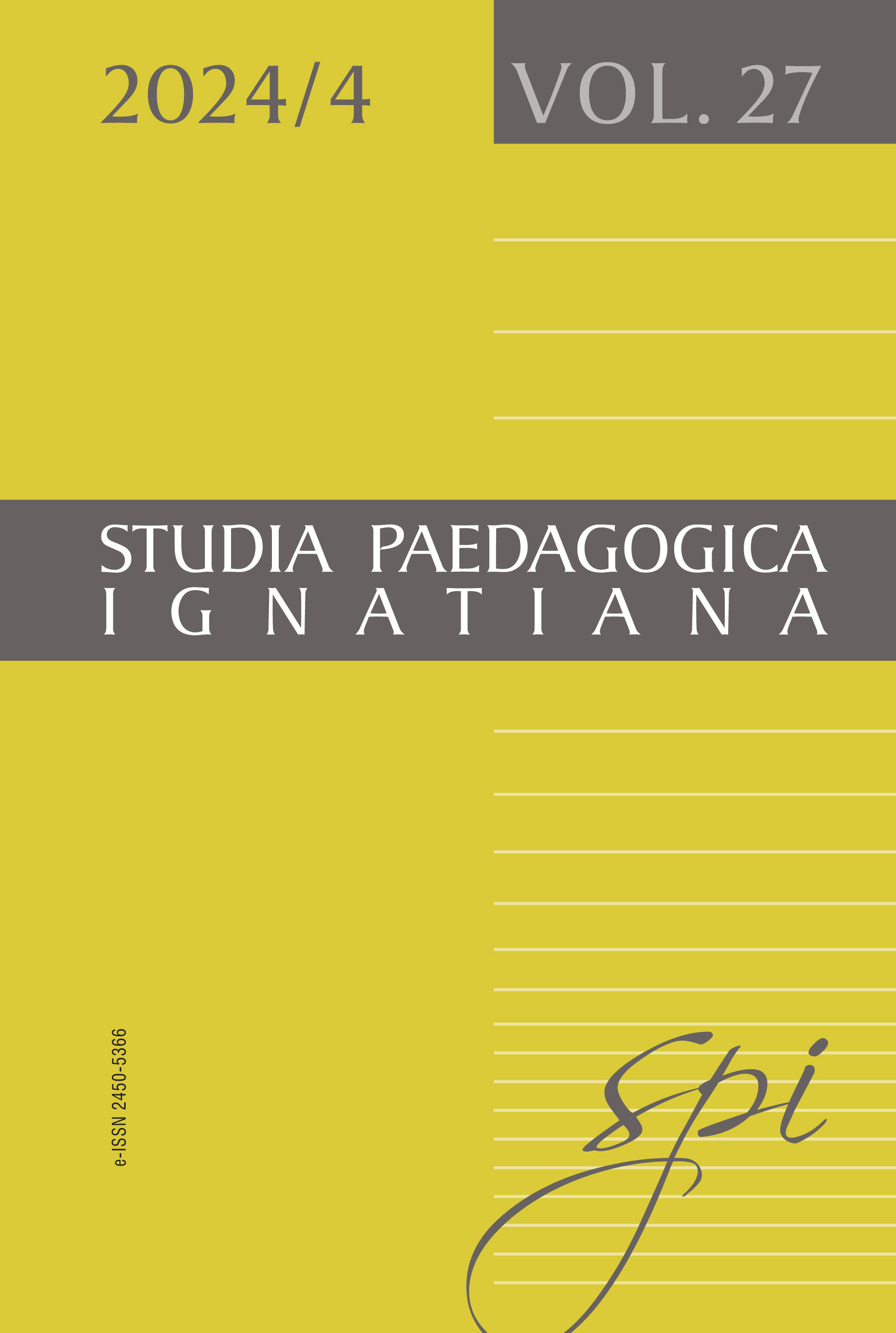Uwarunkowania wycieczek do galerii i muzeów sztuki organizowanych przez nauczycieli edukacji wczesnoszkolnej
DOI:
https://doi.org/10.12775/SPI.2024.4.005Słowa kluczowe
muzea, galerie, wycieczki, edukacja wczesnoszkolna, pandemia COVID-19Abstrakt
Pytania o jakość kształcenia uczniów żyjących w świecie mediów cyfrowych w czasach po pandemii nieuchronnie wyzwalają potrzebę pilnej, zorganizowanej reaktywacji wychowania estetycznego. W najogólniejszym sensie tego rodzaju wychowanie obejmuje wszelkie działania i doświadczenia związane nie tylko z lekturą tekstów kultury, które stymulują i wywołują pełne harmonii przeżycie, ale dodatkowo zakłada aktywne obcowanie dziecka ze sztuką.
Zważywszy na fakt, że szczególnie istotny w rozwoju poczucia estetyki młodszego ucznia, oprócz własnej aktywności ekspresyjnej i twórczej, jest jego osobisty kontakt z dziełami sztuki, autorki artykułu akcentują znaczenie wycieczek do galerii i muzeów sztuki organizowanych przez nauczycieli edukacji wczesnoszkolnej w czasie pozapandemicznym oraz utrudnionej edukacji w tym zakresie w okresie pandemii (rygor sanitarny).
Celem postępowania badawczego było ustalenie czynników warunkujących planowanie i organizowanie przez nauczycieli edukacji wczesnoszkolnej wycieczek z uczniami do muzeów i galerii sztuki. W tekście zaprezentowano wyniki przeprowadzonych analiz dotyczących częstotliwości, potrzeby i uwarunkowań realizacji spotkań uczniów ze sztuką w instytucjach jej upowszechniania, jakie organizują nauczyciele edukacji wczesnoszkolnej.
Bibliografia
Biarincová P. (2023). Vybrané state z výtvarnej edukácie, Ružomberok: Katolícka Univerzita v Ružomberku, Vydavateľstvo Verbum.
Burszta W.J. (2015). Preteksty, Gdańsk: Wydawnictwo Naukowe Katedra.
Eco U. (2019). Na ramionach olbrzymów. Wykłady na festiwalu La Milanesiana w latach 2001–2015, przeł. K. Żaboklicki, Warszawa: Noir Sur Blanc.
Gołaszewski T. (1967). Dziecko w muzeum. Funkcje muzeum w wychowaniu estetycznym dziecka, Warszawa: Instytut Wydawniczy Nasza Księgarnia.
Hejmej A. (2022). Skryptoralność. Literatura w dobie społeczeństwa medialnego, Kraków: Universitas.
Kosno M., Spodaryk M. (2021). Dzieci i sztuka, Kraków: Małopolski Instytut Kultury.
Lowenfeld V., Brittain W.L. (1997). Twórczość a rozwój umysłowy dziecka, przeł. K. Polakowski, Warszawa: Państwowe Wydawnictwo Naukowe.
McLuhan M. (2004). Zrozumieć media. Przedłużenia człowieka, przeł. N. Szczucka, Warszawa: Wydawnictwa Naukowo-Techniczne.
Mirzoeff N. (2016). Jak zobaczyć świat, przeł. Ł. Zaręba, Kraków–Warszawa: Karakter.
Nożyński M., Okólski S. (2021). Kultura w czasie pandemii. Rekonesans dotyczący pierwszych miesięcy funkcjonowania technologicznie zapośredniczonej muzyki w warunkach izolacji, „Annales Universitatis Paedagogicae Cracoviensis. Studia de Cultura”, t. 13, nr 4, s. 63–79, https://doi.org/10.24917/20837275.13.4.5
Papuzińska J. (1988). Inicjacje literackie. Problemy pierwszych kontaktów dziecka z książką, Warszawa: Wydawnictwa Szkolne i Pedagogiczne.
Pater R. (2016). Edukacja muzealna – muzea dla dzieci i młodzieży, Kraków: Wydawnictwo Uniwersytetu Jagiellońskiego.
Piwowarska E., Karbowniczek J., Ordon U. (2023). Early Childhood Education Teachers’ Encounters with Art Presented in Museums and Galleries: Selected Aspects, „Multidisciplinary Journal of School Education”, t. 12, nr 2 (24), s. 419–436, https://doi.org/10.35765/mjse.2023.1224.20
Regiewicz A., Florczyk T. (2022). Dialog muzyki z literaturą. Scenariusze lekcji dla liceum i technikum, Gdańsk: Gdańskie Wydawnictwo Oświatowe.
Skutnik J. (2008). Muzeum sztuki współczesnej jako przestrzeń edukacji, Katowice: Wydawnictwo Uniwersytetu Śląskiego.
Szeląg M. (2014). Raport o stanie edukacji muzealnej. Suplement. Część 1 i 2, Kraków–Warszawa: Universitas, Muzeum Pałacu Króla Jana III w Wilanowie.
Szeląg M., Skutnik J. (red.) (2010). Edukacja muzealna. Antologia tłumaczeń, Poznań: Muzeum Narodowe.
Szuman S. (1962). O sztuce i wychowaniu estetycznym, Warszawa: Państwowe Zakłady Wydawnictw Szkolnych.
Uhrinová M., Vargová M. (2021). Regional Identity in Terms of Professional Training of Future Teachers, [w:] J. Szada-Borzyszkowa, E. Jakubowska (red.), Różnorodność w edukacji dorosłych XXI wieku, Siedlce: Instytut Kultury Regionalnej i Badań Literackich im. Franciszka Karpińskiego. Stowarzyszenie, s. 185–194.
Vetulani J. (2014). Mózg: fascynacje, problemy, tajemnice, Kraków: Homini.
Warzocha A. (2020). Wychowanie do lektury 2.0, Częstochowa: Wydawnictwo Naukowe Uniwersytetu Humanistyczno-Przyrodniczego im. Jana Długosza.
Wojnar I. (1984). Sztuka jako „podręcznik życia”, Warszawa: Nasza Księgarnia.
Pobrania
Opublikowane
Jak cytować
Numer
Dział
Licencja
Prawa autorskie (c) 2024 Ewa Piwowarska, Anna Warzocha, Urszula Ordon - Mizera

Utwór dostępny jest na licencji Creative Commons Uznanie autorstwa – Bez utworów zależnych 4.0 Międzynarodowe.
Autor zgłaszając swój artykuł oświadcza, że:
jest Autorem artykułu (zwanego dalej Utworem) i:
- przysługują mu wyłączne i nieograniczone prawa autorskie do Utworu,
- jest uprawniony/a do rozporządzania prawami autorskimi do Utworu.
Udziela Uniwersytetowi Ignatianum w Krakowie nieodpłatnej, niewyłącznej, nieograniczonej terytorialnie licencji do korzystania z Utworu na następujących polach eksploatacji:
- utrwalania utworu w formie papierowej, a także na nośniku cyfrowym lub magnetycznym;
- zwielokrotnienia utworu dowolną techniką, bez ograniczenia ilości wydań i liczby egzemplarzy;
- rozpowszechniania utworu i jego zwielokrotnionych egzemplarzy na jakimkolwiek nośniku, w tym wprowadzenia do obrotu, sprzedaży, użyczenia, najmu;
- wprowadzenia utworu do pamięci komputera;
- rozpowszechniania utworu w sieciach informatycznych, w tym w sieci Internet;
- publicznego wykonania, wystawienia, wyświetlenia, odtworzenia oraz nadawania i reemitowania, a także publicznego udostępniania utworu w taki sposób, aby każdy mógł mieć do niego dostęp w miejscu i czasie przez siebie wybranym;
- w zakresie praw zależnych do Utworu, obejmujących w szczególności prawo do dokonania koniecznych zmian w Utworze, wynikających z opracowania redakcyjnego i metodycznego, a także do dokonania tłumaczenia Utworu na języki obce.
Udzielenie licencji następuje z chwilą przekazania Utworu na rzecz Uniwersytetowi Ignatianum w Krakowie. Uniwersytet Ignatianum w Krakowie jest uprawniony do udzielania dalszych sublicencji do Utworu, w zakresie udzielonego prawa. Licencja jest ograniczona czasowo i zostaje udzielona na okres 15 lat, licząc od daty jej udzielenia.
Polityka prywatności
Statystyki
Liczba wyświetleń i pobrań: 243
Liczba cytowań: 0



